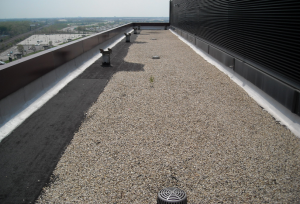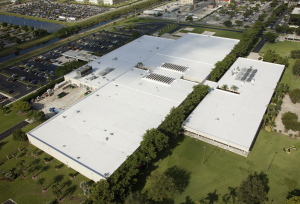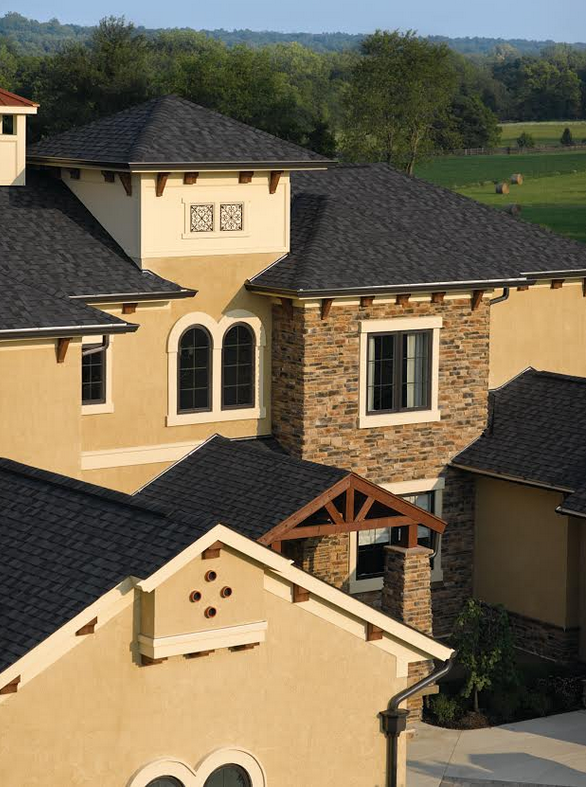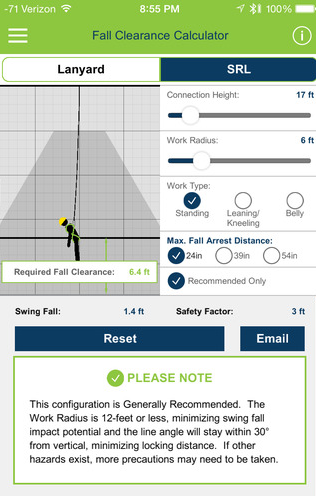There are a number of cool roof options available for asphalt-based roof systems to reduce the temperature of the rooftop and roof membrane, as well as provide building and environmental benefits. Use of conventional white or reflective granules can generate cap sheets with solar reflectance values approaching 0.30. In recent years, manufacturers have begun offering reflective cap sheets that allow construction of highly reflective roof systems. Although a variety of technologies are used to
create these materials, including factory-applied surfacings, metal-foil surfacings and field-applied coatings, they all share a common goal of providing cap sheets with solar reflectance values that range from 0.65 to 0.85.

A ballasted BUR with modified-bitumen flashings over a coverboard and high R-value insulation provides a durable roof system with fire-, wind and impact-resistance. PHOTO: James R. Kirby, AIA
Some of the most exciting advances in the low-slope asphalt roofing industry include peel-and-stick self-adhesive products, as well as new low-fuming asphalt formulations that are popular choices today, particularly when controlling asphalt-fume exposure is a priority. The beauty of cold-process adhesive application and low-fuming asphalt is that they have been used successfully on high-density, fume-sensitive-occupancy-type buildings, such as health-care facilities, schools and college campuses, food-preparation centers, airports, fashion malls, fine hotels, financial/ office centers and automotive factories.
Proper installation of asphaltic-based roof systems is critical to their long-term success. Quality roofing contractors will pay particular attention to flashing details, such as curbs, walls, pipes, mechanical supports or other projections that interrupt the membrane. Attention to detail achieves a quality, high-performance and long-lasting roof system for the building owner. Asphalt-based roof system flashings are used for many penetration and detail configurations. Roof manufacturers have products that are suitable for common details, and asphaltic materials are adaptable to meet unique details that may be encountered on a roofing project. One way to help ensure a quality installation and long-term performance is to use contractors who are certified, or accredited, by the manufacturer of the materials to be installed.
Building owners and facility managers play a key role in meeting, or exceeding, the anticipated service life of an asphaltic roof system. Regular maintenance of a roof system is critical to a long service life and ensures small issues are identified and repaired before they become large, expensive ones, or worse, before they deteriorate a roof system to the point of needing replacement. Having an “out of sight, out of mind” maintenance approach can easily lead to significantly reduced performance and service life.
It’s best practice for building owners to inspect their roofs twice a year—in the spring and the fall, according to the ARMA/NRCA Manual for Inspection and Maintenance of Built-up and Modified Bitumen Roof Systems: A Guide for Building Owners. Additionally, a roof should be inspected after significant weather events, like a hailstorm or an extreme wind event. Owners should obtain the roof system manufacturer’s warranty, the installing contractor’s warranty and ideally should establish a semi—annual service program with the installing contractor. Regular maintenance and inspections help extend the life of an asphalt—based roof system. Savvy building owners will not only analyze initial costs, but also will forecast annualized long-term costs over the decades-long expected service life of their asphalt-based roof systems.

A highly reflective modified bitumen roof system reduces solar heat gain in Climate Zone 1, and high wind resistance helps ensure longevity in a hurricane zone. PHOTO: Smith Aerial Photos
MEETING TODAY’S NEEDS
Long service life for asphalt-based roof systems relies on a good design, quality materials, proper installation and regular maintenance. Manufacturers across North America are making asphalt roof systems better and more versatile for architects, builders, contractors, roofing consultants and building owner/managers. Thanks to the addition of polymers that add stretch and strength, contractors can now apply low-slope asphalt-based roof systems in a variety of ways—hot asphalt, cold adhesive, torch- or heat-welded, or self-adhered— to meet any low-slope roofing project’s needs. Today’s asphalt roofing products are beautiful, affordable, reliable and are trusted to perform exceptionally well against extreme weather conditions.
LEARN MORE
View more information about all types of asphalt roofing.




Thank you ARMA and Mr. Kirby. Excellent, timely article. Mr. Kirby “nailed-it” and highlighted the key points to designing a high-performance roof eloquently. I currently have designed over 15-million square feet of high-quality, multi-ply (two, fully-mopped, Type IV Fiberglass Felt base-sheet in the old days before the modified base sheets were introduced and proven) APP, torch-grade roofs, predominately in the Midwest. My first designs date back to 1981 when I was a Senior Architect at WJE (Northbrook Headquarters until I was one of the original Architects and Engineers to open the Chicago Office). To date, all of my roofs are still in-place and still in good condition with one exception. I had one Derbigum roof prematurely fail (still watertight, but severely wrinkled after one-year), which was removed and replaced immediately by the Manufacturer, at no cost to the Owner (including my time). Mr. Kirby’s emphasis on implementing a biannual Roof Maintenance Program was so spot-on and even mandatory to maintain the Roof Warranty. However, getting the Owners to follow-through is another matter. Remember when modified-bitumens first hit the market and they were clumped together with rubber and PVC and generically labeled a “Single-PLY”? Today, I do not have to “sell” the use of Modified Bitumen Systems anymore. I am an actual “Resource” on why they are the best. Unfortunately, initial installation costs can be a factor. However, when this occurs on my projects, all I do is take my small “sample” of the roof that I want to specify, and grab a “sample” of the Single-ply that they were told is “as good” and head to their office. I set down the two samples for them to hold and physically examine, discuss the often less than 33% initial cost savings, show them the single-ply warranty that becomes void if they step on the roof and are not on a walkway pad, and then ask them, “which roof system did you want me to specify?”
Thanks
Respectfully yours,
Reiner A. Pligge, AIA
Mr. Pligge,
As a practitioner with much experience, I appreciate your comments.
Thank you for taking time to post them.
Jim